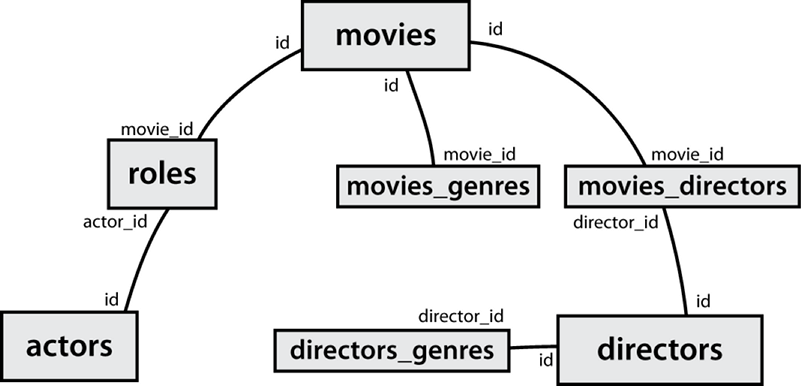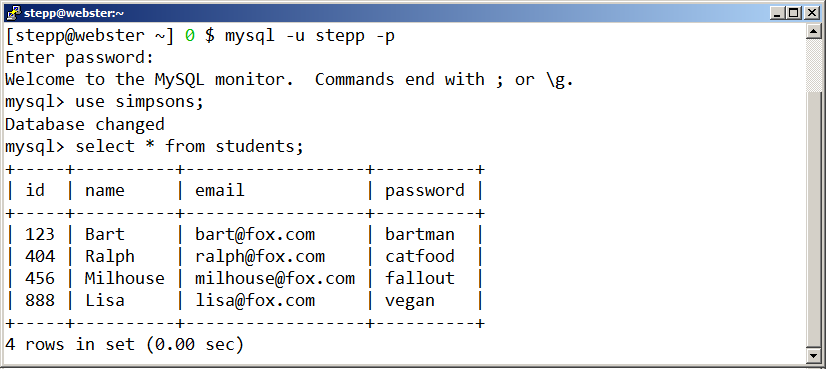CSE 190M Web Programming
Lecture 12: More SQL, JOINS
Reading: 13.2 - 13.5
Except where otherwise noted, the contents of this document are
Copyright 2012 Marty Stepp, Jessica Miller, Victoria Kirst and Roy McElmurry IV.
All rights reserved.
Any redistribution, reproduction, transmission, or storage of part
or all of the contents in any form is prohibited without the author's
expressed written permission.
13.3: Multi-table Queries
-
13.1: Database Basics
-
13.2: SQL
-
13.3: Multi-table Queries
-
13.4: Databases and PHP
Related tables and keys
students
| id | name | email |
|---|
| 123 | Bart | bart@fox.com |
| 456 | Milhouse | milhouse@fox.com |
| 888 | Lisa | lisa@fox.com |
| 404 | Ralph | ralph@fox.com |
|
courses
| id | name | teacher_id |
|---|
| 10001 | Computer Science 142 | 1234 |
| 10002 | Computer Science 143 | 5678 |
| 10003 | Computer Science 190M | 9012 |
| 10004 | Informatics 100 | 1234 |
|
grades
| student_id | course_id | grade |
|---|
| 123 | 10001 | B- |
| 123 | 10002 | C |
| 456 | 10001 | B+ |
| 888 | 10002 | A+ |
| 888 | 10003 | A+ |
| 404 | 10004 | D+ |
|
teachers
| id | name |
|---|
| 1234 | Krabappel |
| 5678 | Hoover |
| 9012 | Stepp |
|
- primary key: a column guaranteed to be unique for each record (e.g. Lisa Simpson's ID 888)
- foreign key: a column in table A storing a primary key value from table B
- (e.g. records in
grades with student_id of 888 are Lisa's grades)
- normalizing: splitting tables to improve structure / redundancy (linked by unique IDs)
Querying multi-table databases
When we have larger datasets spread across multiple tables, we need queries that can answer high-level questions such as:
- What courses has Bart taken and gotten a B- or better?
- What courses have been taken by both Bart and Lisa?
- Who are all the teachers Bart has had?
- How many total students has Ms. Krabappel taught, and what are their names?
To do this, we'll have to join data from several tables in our SQL queries.
Exercise: Multi-table query
- Use your existing SQL knowledge to determine how well Bart did in CSE 142.
Cross product with JOIN
SELECT column(s) FROM table1 JOIN table2;
SELECT * FROM students JOIN grades;
| id | name | email | student_id | course_id | grade |
|---|
| 123 | Bart | bart@fox.com | 123 | 10001 | B- |
| 404 | Ralph | ralph@fox.com | 123 | 10001 | B- |
| 456 | Milhouse | milhouse@fox.com | 123 | 10001 | B- |
| 888 | Lisa | lisa@fox.com | 123 | 10001 | B- |
| 123 | Bart | bart@fox.com | 123 | 10002 | C |
| 404 | Ralph | ralph@fox.com | 123 | 10002 | C |
| ... (24 rows returned) |
- cross product or Cartesian product: combines each row of first table with each row of second
- produces M * N rows, where table 1 has M rows and table 2 has N
- problem: produces too much irrelevant/meaningless data
Joining with ON clauses
SELECT column(s)
FROM table1
JOIN table2 ON condition(s)
...
JOIN tableN ON condition(s);
SELECT *
FROM students
JOIN grades ON id = student_id;
- join: combines records from two or more tables if they satisfy certain conditions
- the
ON clause specifies which records from each table are matched
- the rows are often linked by their key columns (id)
Join example
SELECT *
FROM students
JOIN grades ON id = student_id;
| id | name | email | student_id | course_id | grade |
|---|
| 123 | Bart | bart@fox.com | 123 | 10001 | B- |
| 123 | Bart | bart@fox.com | 123 | 10002 | C |
| 404 | Ralph | ralph@fox.com | 404 | 10004 | D+ |
| 456 | Milhouse | milhouse@fox.com | 456 | 10001 | B+ |
| 888 | Lisa | lisa@fox.com | 888 | 10002 | A+ |
| 888 | Lisa | lisa@fox.com | 888 | 10003 | A+ |
Filtering columns in a join
SELECT name, course_id, grade
FROM students
JOIN grades ON id = student_id;
| name | course_id | grade |
|---|
| Bart | 10001 | B- |
| Bart | 10002 | C |
| Ralph | 10004 | D+ |
| Milhouse | 10001 | B+ |
| Lisa | 10002 | A+ |
| Lisa | 10003 | A+ |
Filtered join (JOIN with WHERE)
SELECT name, course_id, grade
FROM students
JOIN grades ON id = student_id
WHERE name = 'Bart';
| name | course_id | grade |
|---|
| Bart | 10001 | B- |
| Bart | 10002 | C |
FROM / JOIN glue the proper tables together, and WHERE filters the results- what goes in the
ON clause, and what goes in WHERE?
ON directly links columns of the joined tablesWHERE sets additional constraints such as particular values (123, 'Bart')
What's wrong with this?
SELECT name, id, course_id, grade
FROM students
JOIN grades ON id = 123
WHERE id = student_id;
| name | id | course_id | grade |
|---|
| Bart | 123 | 10001 | B- |
| Bart | 123 | 10002 | C |
- The above query produces the same rows as the previous one, but it is poor style. Why?
-
The
JOIN ON clause is poorly chosen. It doesn't really say what connects a grades record to a students record.
- They are related when they are for a student with the same
id.
- Filtering out by a specific ID or name should be done in the
WHERE clause, not JOIN ON.
Giving names to tables
SELECT s.name, g.*
FROM students s
JOIN grades g ON s.id = g.student_id
WHERE g.grade <= 'C';
| name | student_id | course_id | grade |
|---|
| Bart | 123 | 10001 | B- |
| Bart | 123 | 10002 | C |
| Milhouse | 456 | 10001 | B+ |
| Lisa | 888 | 10002 | A+ |
| Lisa | 888 | 10003 | A+ |
- can give names to tables, like a variable name in Java
- to specify all columns from a table, write
table.*
- (
grade column sorts alphabetically, so grades C or better are ones <= it)
Multi-way join
SELECT c.name
FROM courses c
JOIN grades g ON g.course_id = c.id
JOIN students bart ON g.student_id = bart.id
WHERE bart.name = 'Bart' AND g.grade <= 'B-';
| name |
|---|
| Computer Science 142 |
- More than 2 tables can be joined, as shown above
- What does the above query represent?
- The names of all courses in which Bart has gotten a B- or better.
Exercise: Incremental JOIN query
-
Use the same approach as before to determine what courses
have been taken by both Bart and Lisa?
SELECT bart.course_id
FROM grades bart
JOIN grades lisa ON lisa.course_id = bart.course_id
WHERE bart.student_id = 123
AND lisa.student_id = 888;
problem: requires us to know Bart/Lisa's Student IDs, and only
spits back course IDs, not names.
-
Write a version of this query that gets us the course
names, and only requires us to know Bart/Lisa's names, not their IDs.
Designing a query
- Figure out the proper SQL queries in the following way:
- Which table(s) contain the critical data? (
FROM)
- Which columns do I need in the result set? (
SELECT)
- How are tables connected (
JOIN) and values filtered (WHERE)?
- Test on a small data set (
imdb_small).
- Confirm on the real data set (
imdb).
- Try out the queries first in the MySQL console.
- Write the PHP code to run those same queries.
- Make sure to check for SQL errors at every step!!
Exercise: More JOIN queries
- What are the names of all teachers Bart has had?
SELECT DISTINCT t.name
FROM teachers t
JOIN courses c ON c.teacher_id = t.id
JOIN grades g ON g.course_id = c.id
JOIN students s ON s.id = g.student_id
WHERE s.name = 'Bart';
- How many total students has Ms. Krabappel taught, and what are their names?
SELECT DISTINCT s.name
FROM students s
JOIN grades g ON s.id = g.student_id
JOIN courses c ON g.course_id = c.id
JOIN teachers t ON t.id = c.teacher_id
WHERE t.name = 'Krabappel';
Example imdb database
actors
| id | first_name | last_name | gender |
|---|
| 433259 | William | Shatner | M |
| 797926 | Britney | Spears | F |
| 831289 | Sigourney | Weaver | F |
| ... |
movies
| id | name | year | rank |
|---|
| 112290 | Fight Club | 1999 | 8.5 |
| 209658 | Meet the Parents | 2000 | 7 |
| 210511 | Memento | 2000 | 8.7 |
| ... |
roles
| actor_id | movie_id | role |
|---|
| 433259 | 313398 | Capt. James T. Kirk |
| 433259 | 407323 | Sgt. T.J. Hooker |
| 797926 | 342189 | Herself |
| ... |
movies_genres
| movie_id | genre |
|---|
| 209658 | Comedy |
| 313398 | Action |
| 313398 | Sci-Fi |
| ... |
directors
| id | first_name | last_name |
|---|
| 24758 | David | Fincher |
| 66965 | Jay | Roach |
| 72723 | William | Shatner |
| ... |
movies_directors
| director_id | movie_id |
|---|
| 24758 | 112290 |
| 66965 | 209658 |
| 72723 | 313398 |
| ... |
- also available,
imdb_small with fewer records (for testing queries)
IMDb table relationships / ids
IMDb query example
[stepp@webster ~]$ mysql -u myusername -p
Enter password:
Welcome to the MySQL monitor. Commands end with ; or \g.
mysql> use imdb_small;
Database changed
mysql> select * from actors where first_name like '%mick%';
+--------+------------+-----------+--------+
| id | first_name | last_name | gender |
+--------+------------+-----------+--------+
| 71699 | Mickey | Cantwell | M |
| 115652 | Mickey | Dee | M |
| 470693 | Mick | Theo | M |
| 716748 | Mickie | McGowan | F |
+--------+------------+-----------+--------+
4 rows in set (0.01 sec)
Exercise: IMDB practice queries
- What are the names of all movies released in 1995?
- How many people played a part in the movie "Lost in Translation"?
- What are the names of all the people who played a part in the movie "Lost in Translation"?
- Who directed the movie "Fight Club"?
- How many movies has Clint Eastwood directed?
- What are the names of all movies Clint Eastwood has directed?
- What are the names of all directors who have directed at least one horror film?
- What are the names of every actor who has appeared in a movie directed by Christopher Nolan?
Learning about databases and tables
SHOW DATABASES;
SHOW TABLES;
DESCRIBE table;
SHOW TABLES;
+-----------+
| students |
| courses |
| grades |
| teachers |
+-----------+ 4 rows in set
The SQL statement
INSERT INTO table
VALUES (value, value, ..., value);
INSERT INTO students
VALUES (789, "Nelson", "muntz@fox.com", "haha!");
- adds a new row to the given table
- columns' values should be listed in the same order as in the table
- How would we record that Nelson took CSE 190M and got a D+ in it?
More about INSERT
INSERT INTO table (columnName, columnName, ..., columnName)
VALUES (value, value, ..., value);
INSERT INTO students (name, email)
VALUES ("Lewis", "lewis@fox.com");
- some columns have default or auto-assigned values (such as IDs)
- omitting them from the INSERT statement uses the defaults
The SQL statement
REPLACE INTO table (columnName, columnName, ..., columnName)
VALUES (value, value, ..., value);
REPLACE INTO students
VALUES (789, "Martin", "prince@fox.com");
- just like INSERT, but if an existing row exists for that key (ID), it will be replaced
- can pass optional list of column names, like with INSERT
The SQL statement
UPDATE table
SET column = value,
...,
column = value
WHERE column = value;
UPDATE students
SET email = "lisasimpson@gmail.com"
WHERE id = 888;
- modifies an existing row(s) in a table
- BE CAREFUL! If you omit the WHERE, it modifies ALL rows
The SQL statement
DELETE FROM table
WHERE condition;
DELETE FROM students
WHERE id = 888;
- removes existing row(s) in a table
- can be used with other syntax like LIMIT, LIKE, ORDER BY, etc.
- BE CAREFUL! If you omit the WHERE, it deletes ALL rows
and
an entire database
CREATE DATABASE name;
DROP DATABASE name;
CREATE DATABASE warcraft;
- adds/deletes an entire database from the server
Creating and deleting a table
CREATE TABLE name (
columnName type constraints,
...
columnName type constraints
);
DROP TABLE name;
CREATE TABLE students (
id INTEGER,
name VARCHAR(20),
email VARCHAR(32),
password VARCHAR(16)
);
- adds/deletes a table from this database
- all columns' names and types must be listed (see next slide)
SQL
BOOLEAN: either TRUE or FALSEINTEGERDOUBLEVARCHAR(length) : a stringENUM(value, ..., value): a fixed set of valuesDATE, TIME, DATETIMEBLOB : binary data
Column constraints
CREATE TABLE students (
id INTEGER UNSIGNED NOT NULL PRIMARY KEY,
name VARCHAR(20) NOT NULL,
email VARCHAR(32),
password VARCHAR(16) NOT NULL DEFAULT "12345"
);
NOT NULL: not allowed to insert a null/empty value in any row for that columnPRIMARY KEY / UNIQUE: no two rows can have the same valueDEFAULT value: if no value is provided, use the given defaultAUTO_INCREMENT: default value is the last row's value plus 1 (useful for IDs)UNSIGNED: don't allow negative numbers (INTEGER only)
Rename a table
ALTER TABLE name RENAME TO newName;
ALTER TABLE students RENAME TO children;
- changes the name of an existing table
Add/remove/modify a column in a table
ALTER TABLE name
ADD COLUMN columnName type constraints;
ALTER TABLE name DROP COLUMN columnName;
ALTER TABLE name
CHANGE COLUMN oldColumnName newColumnName type constraints;
- adds/deletes/respecifies a column in an existing table
- if a column is added, all existing rows are given a default value for that column
Database Design
-
13.1: Database Basics
-
13.2: SQL
-
13.3: Multi-table Queries
-
13.4: Databases and PHP
Database design principles
- database design : the act of deciding the schema for a database
- database schema: a description of what tables a database should have, what columns each table should contain, which columns' values must be unique, etc.
- some database design principles:
- keep it simple, stupid (KISS)
- provide an identifier by which any row can be uniquely fetched
- eliminate redundancy, especially of lengthy data (strings)
- integers are smaller than strings and better to repeat
- favor integer data for comparisons and repeated values
- integers are smaller than strings and better to repeat
- integers can be compared/searched more quickly than strings, real numbers
First database design
student_grades
| name | email | course | teacher | grade |
|---|
| Bart | bart@fox.com | Computer Science 142 | Krabappel | B- |
| Bart | bart@fox.com | Computer Science 143 | Hoover | C |
| Milhouse | milhouse@fox.com | Computer Science 142 | Krabappel | B+ |
| Lisa | lisa@fox.com | Computer Science 143 | Hoover | A+ |
| Lisa | lisa@fox.com | Computer Science 190M | Stepp | A+ |
| Ralph | ralph@fox.com | Informatics 100 | Krabappel | D+ |
- what's good and bad about this design?
- good: simple (one table), can see all data in one place
- bad: redundancy (name, email, course repeated frequently)
- bad: most searches (e.g. find a student's courses) will have to rely on string comparisons
- bad: there is no single column whose value will be unique in each row
Improved database design
students
| id | name | email |
|---|
| 123 | Bart | bart@fox.com |
| 456 | Milhouse | milhouse@fox.com |
| 888 | Lisa | lisa@fox.com |
| 404 | Ralph | ralph@fox.com |
|
courses
| id | name | teacher_id |
|---|
| 10001 | Computer Science 142 | 1234 |
| 10002 | Computer Science 143 | 5678 |
| 10003 | Computer Science 190M | 9012 |
| 10004 | Informatics 100 | 1234 |
|
grades
| student_id | course_id | grade |
|---|
| 123 | 10001 | B- |
| 123 | 10002 | C |
| 456 | 10001 | B+ |
| 888 | 10002 | A+ |
| 888 | 10003 | A+ |
| 404 | 10004 | D+ |
|
teachers
| id | name |
|---|
| 1234 | Krabappel |
| 5678 | Hoover |
| 9012 | Stepp |
|
- normalizing: splitting tables to improve structure / redundancy (linked by unique IDs)
- primary key: a column guaranteed to be unique for each record (e.g. Lisa Simpson's ID 888)
- foreign key: a column in table A storing a primary key value from table B
- (e.g. records in
grades with student_id of 888 are Lisa's grades)
Database design exercise
Suppose we want to write a web store like Amazon.com.
The store sells products that can be purchased by customers online.
The customer can add items to their shopping cart and then order them.
The customer can also check the order's status, whether it has shipped, etc.
- What are some database tables and columns we could use?
- Is your design normalized? Does it have any redundancy?
Connecting to a server in a terminal
-
You can talk to a database directly using a secure shell (SSH) terminal program such as .
-
Open your SSH program and connect to
webster.cs.washington.edu.
-
in a Mac/Linux Terminal window, type:
ssh yourUWnetID@webster.cs.washington.edu
-
Log in with your normal UW NetID and password.
Using the MySQL console
Once connected via SSH, type the following command at the prompt:
mysql -u username -p
Type in your MySQL password (should have been emailed to you).
The screen will not show anything as you type the password.
Now at the mysql> prompt, you can type SQL commands. End each with a semicolon ;.






